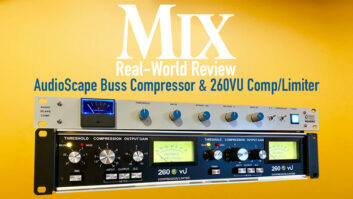
The Retro Instruments Sta-Level improves on the original ’50s Gates Sta-Level via some critical components and added adjustability, while staying true to the original unit’s best traits.
For instance, Phil Moore, the designer of the new Sta-Level, uses a custom-wound, copper-and-steel shielded output transformer, along with a custom power transformer. According to Moore, the input transformer is a high-quality Cinemag product by Altec transformer guru Tom Reichenbach. The resistors are carbon film instead of the original carbon-composition types, providing quieter operation and reliability in the Retro.
The tubes that ship with the unit are the readily available 6BJ6s, but you can add a 6386 to replace the pair of 6BJ6s or run them in parallel to average out individual tube imbalances. The 6386’s socket is on the back and easily accessible. All tubes are selected for proper biasing, noise and matching. The back also carries an RCA socket for strapping together multiple units.
DYNAMIC CONTROL
As simple as it looks, the Sta-Level is surprisingly versatile due to its internal and external attack/release adjustments. On the outside, the Recovery knob does just as you’d expect — it sets the recovery time of the compressor after the signal slips below the threshold. The original Sta-Level’s recovery time was said to be measured in weeks, but this handy addition makes the new unit much more usable.
On the inside, behind the easily opened, hinged front panel, a rotary adjustment calibrates the VU meter and a three-position toggle picks your attack/release poison: Double, Single and Fast. Double is program-controlled attack/release that builds density without pumping, much like the original Sta-Level. Single produces slow attack and release, with the needle seemingly painted in position. This mode changes the operational feel of the release control. Lastly, Fast performs much like the Fairchild 660, combining program-controlled release and fast attack. This mode tends to put the lid down on transients quickly and is the least transparent of the three modes. To make it even more interesting, the Recovery knob is active no matter which of the three modes you pick.
MAKING MAGIC
My first listen to the Sta-Level was as an insert compressor across a Mojave MA-200 microphone placed as a mono overhead about six feet back from a drum kit in a medium-sized room. The Sta-Level was set with a medium-slow recovery time (about 11 o’clock on the dial) and represented the kit nicely in the room. As you would expect, the compressor brought up the room detail but with a very relaxed attack (set to Double) and release, making it almost transparent — of course, not so transparent that you didn’t know it was compressed, but the Sta-Level’s overall touch on the track rendered an in-your-face kit with some tube grunge. To hear this, visit “Online Extras” at www.mixonline.com.
The relationship between the Sta-Level and a vocal is nothing short of love. It gives the track that certain something that says, “This is a record.” I first heard it on a percussive and very dynamic rap vocal. After setting the unit to Double attack with the recovery at 11 o’clock, the vocal sat down in the mix, letting me tuck it lower than I normally would without losing audibility. It worked equally well on another vocal track in series after an 1176 that was set to grab just the attacks. The Sta-Level literally cemented the vocal to the track, making it sit perfectly in the mix.
I could really see the benefits of the three-position attack switch using the Sta-Level across an acoustic guitar recorded at a medium tempo with a Shure SM7 mic through an SSL 4000 G+. In the Fast position, you could really hear it pumping, which didn’t fit the intended application. At the Double setting, the attack was slower, but pumping was still in evidence. The Single mode was just the ticket: The guitar stayed put in the mix, sounding incredibly smooth and in-your-face.
What was especially amazing is what the Sta-Level did to an acoustic guitar recorded with a single Avantone AK-Type VII mic. The mic sounded very good on the guitar but was a bit tubby at the bottom end. It may have been a placement issue, but it was already on tape and needed help. Once the Sta-Level was put across the insert with about 5 dB of gain reduction at the Double setting and Recovery set so it was very relaxed, it completely changed the sound for the better. It brought out a nice, silky top and tightened up the bottom end, taking out the boxiness.
I’VE GOT A CRUSH
The Sta-Level defines creamy smoothness when it comes to tube compression. I’ve used it on a number of sources, from a lowly hi-hat to a lead vocal, and each time its personality makes you want more. I can’t say enough about using the three-position switch with the Recovery knob. It makes this compressor eminently usable on almost anything you throw at it. If that type of control isn’t enough, you can dink with the tubes by plugging in a 6386 at the back and add that flavor to your mix.
One warning is that this unit needs to warm up for a long time to sound optimal. I first heard it after an hour of warmup, and it sounded even better three hours later. My only regret is that I wish I’d had two to units to throw across the stereo bus. Price: $2,350.
Dist. by Vintage King Audio, 248/591-9276, www.vintageking.com.
Kevin Becka is Mix’s technical editor.







